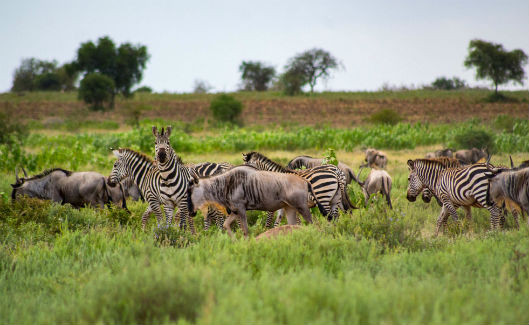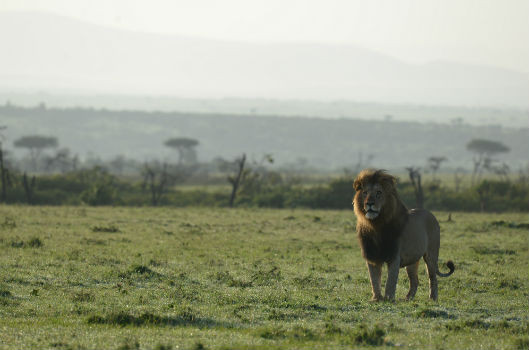Human societies around the world are experiencing a historic loss of biological diversity and abundance. Newly released research describes how people have caused the loss of 83 percent of all wild animals and about half of all plants. Humans now impact 75 percent of the earth’s land surface, and approximately 60 percent of the world’s large mammals are threatened with extinction.
These kinds of dramatic data points make it clear that addressing the scope of the challenges facing conservation efforts around the world today will require concerted action on a much larger scale than has happened to date. It is equally clear that conservation challenges are increasingly complex, comprised of multi-faceted social, institutional, and ecological factors that span the local to the global.
Yet conservation efforts traditionally have suffered from excessively siloed or territorial approaches, internal conflicts, or competition for funding, influence, and recognition. They also have a tendency to operate through relatively isolated field projects.
To overcome these challenges, conservation efforts need to more aggressively adopt ideas and approaches to systems leadership and collective action that involve new ways of working together across organizational fiefdoms and disciplinary siloes. Fortunately, some promising new models of collaboration—often based around new organizations or networks explicitly designed to support collective action and collaboration—are emerging. These efforts have the potential to scale solutions across landscapes or entire countries, to effectively link together the local and global arenas, and to better mobilize funding.
Collaborating at the landscape scale
Are you enjoying this article? Read more like this, plus SSIR's full archive of content, when you subscribe.
Conservation outcomes are fundamentally tied to processes—such as the movement of water across a watershed or river basin, or the annual migrations of animal species—that occur on a relatively large ecosystem, or landscape, scale. Delivering results on this scale, especially in complex landscapes with diverse government, private, and community actors, can only happen through collaboration.
The Northern Tanzania Rangelands Initiative (NTRI) is a novel collaboration that aims to bring together local and international organizations in pursuit of landscape-scale outcomes in the country’s savannah grasslands, home to some of the world’s greatest assemblages of wildlife. Formed about five years ago by eight collaborating organizations, including international conservation groups such as the Wildlife Conservation Society and The Nature Conservancy, and entrepreneurial local organizations such as Carbon Tanzania and Honeyguide, which help local communities manage and benefit from wildlife and forests. NTRI has developed a common vision, setting clear goals that focus on priorities like securing community rights over land, and increasing benefits from wildlife tourism and other nature-based enterprises. The collaboration has also helped mobilize the variety of skills and resources needed to coordinate and create impact on multiple levels.
 Delivering conservation on a scale sufficient to protect migratory wildlife in East African ecosystems, such as these wildebeest and zebra on community lands outside Tanzania’s Tarangire National Park, requires collaboration at the scale of these large landscapes. (Photo by Roshni Lodhia)
Delivering conservation on a scale sufficient to protect migratory wildlife in East African ecosystems, such as these wildebeest and zebra on community lands outside Tanzania’s Tarangire National Park, requires collaboration at the scale of these large landscapes. (Photo by Roshni Lodhia)
One way it is doing this is by helping generate financial support for grassroots organizations such as the Ujamaa Community Resource Team (UCRT), whose work focuses on securing the land rights of Maasai communities and other indigenous peoples in the region. This support has helped UCRT work with communities to better protect and manage more than one million acres of community rangelands over the past five years, while also supporting new models of community-based wildlife conservation. By teaming up with UCRT, and with the support of the wider NTRI collaboration, Carbon Tanzania initiated a carbon-offset project that has helped the Hadzabe, a unique indigenous hunter-gatherer community, earn more than $200,000 from protecting nearly 50,000 acres of forests over the past four years. This cash income, in turn, enables communities to improve the protection of their lands by investing in the enforcement of land-use regulations. It also helps support local social services in remote areas. This model is now in the process of scaling up to protect more than 300,000 acres of community lands that are also home to wildlife such as elephants, lions, and endangered wild dogs.
Innovative conservation models like this depend on diverse organizations pooling their skills, resources, and experiences in pursuit of common goals and interests. NTRI is a promising example of what can happen when a group of organizations sets ambitious conservation goals at the landscape scale, and then mobilizes the resources and facilitates the partnerships required to deliver on them.
Scaling new models
As mentioned above, a core challenge facing conservation is that many local projects emerge in isolation. This creates two problems: 1) The initiatives never coalesce into a wider movement, and 2) they often have no systematic way of learning from each other, resulting in massive inefficiency and duplication of effort.
The Kenya Wildlife Conservancies Association (KWCA) formed five years ago to address these problems by creating a new national conservation movement based on local leadership. During the previous 20 years, numerous local conservancies had sprung up in response to unique local social and ecological conditions in different parts of the country. KWCA aimed to give these local conservancies a common voice, work for a unifying policy and legal framework at the national level, and enable the local organizations to learn from each other in their design and development.
Landowners around Kenya increasingly view conservancies as a way to access new economic opportunities through wildlife tourism, as well as be part of a national conservation movement that both government and private investors have increasingly embraced. KWCA has been able to bridge local communities and national policymaking, giving a much-needed boost to local influence in the country’s conservation policy.
Similar approaches by collaborative networks in Namibia have helped inspire new models for locally led collaboration. Over the past 25 years, a combination of protected areas—including national parks, private game ranches, and local community conservancies—have combined to put more than 40 percent of the country’s total land area under conservation management.
A key to Namibia’s success has been exceptionally strong partnerships between local organizations, government, and international groups such as World Wildlife Fund. NACSO, a coordinating body for the country’s community-based approach to conservation and natural resource management, has played a central role in building trust between these groups. As Maxi Louis, the coordinator of NACSO, explains, “The biggest strength we have is our partnerships. If we were just implementing our programs on an individual basis, we would not have had the success in Namibia that we’ve had.”
“Co-funding” conservation
Conservation efforts in Africa and around the world also struggle with insufficient funding, and much of the funding that is available is misallocated. But it’s not just a matter of more money; conservation funding needs to take more of a collective action approach that pools funding from multiple sources, helps direct it towards the best models based on results and impact, and provides a more compelling case for both private and public investment.
One of our organizations, the Wildlife Conservation Network (WCN), launched a new Lion Recovery Fund in partnership with the Leonardo DiCaprio Foundation last year. Lion populations have declined precipitously across Africa over the past 30 years, and the fund aims to source and fund the best ideas and conservation models that can advance the goal of doubling lion numbers and restoring their broader landscapes. The fund explicitly aims to scale up funding for lion conservation, recognizing that roughly 75 percent of protected areas in lions’ range in Africa operate on a budget deficit, many with only around 10 percent of the funding they need to deliver conservation results. In other words, a step change in African conservation funding is needed—relatively fast— to protect species like lions, elephants, and other wide-ranging species.
 The Lion Recovery Fund is a new initiative seeking to promote effective approaches to reversing the declines of Africa’s lions, as well as collaboration between conservation practitioners and funders. (Photo by Nicholas Lapham)
The Lion Recovery Fund is a new initiative seeking to promote effective approaches to reversing the declines of Africa’s lions, as well as collaboration between conservation practitioners and funders. (Photo by Nicholas Lapham)
By identifying and supporting the best local lion conservation initiatives, developing new funding partnerships, and creating stronger platforms for collaboration, the Lion Recovery Fund hopes to support the long-term recovery of lions across their range. The fund is developing new collaborations with unexpected allies in the tourism and fashion industries, as well as with other conservation funders like the National Geographic Society’s Big Cats Initiative, which supports more than 100 projects that are working to conserve species like lions and cheetah in 28 countries.
Other innovative collaborations conservation organizations should adapt and replicate include Oceans5, a marine conservation funding consortium, and the Project Finance for Permanence model developed by the Linden Trust for Conservation and other partners. Conservationists also need to draw more widely on new collaborative philanthropic models that can help leverage greater overall investment in conservation, and improve the results and impact associated with that investment.
Successful conservation efforts, in Africa and around the world, require that we scale up the best local models, build stronger national movements that can promote learning and influence policy, and catalyze greater and more effective funding. And doing these things requires that we invest in strong and diverse collaborations that link global networks and resources to innovative and locally rooted conservation groups. To save the planet, conservationists need to usher in a new era of collaboration.
Support SSIR’s coverage of cross-sector solutions to global challenges.
Help us further the reach of innovative ideas. Donate today.
Read more stories by Jeffrey Parrish & Fred Nelson.

